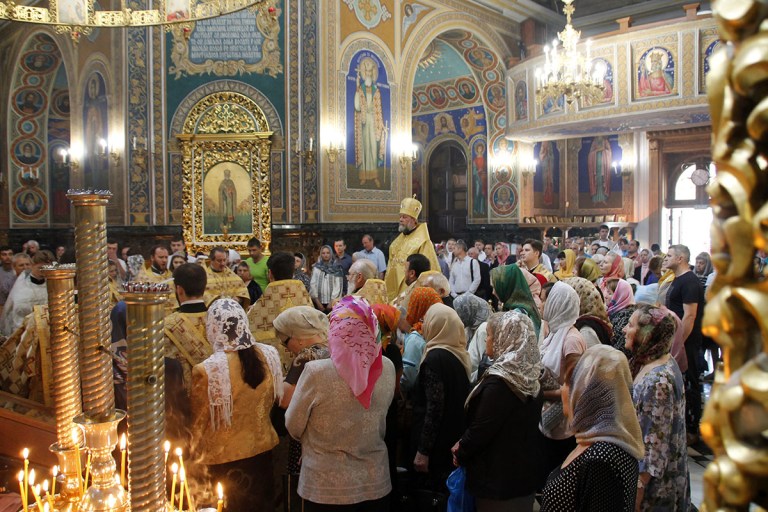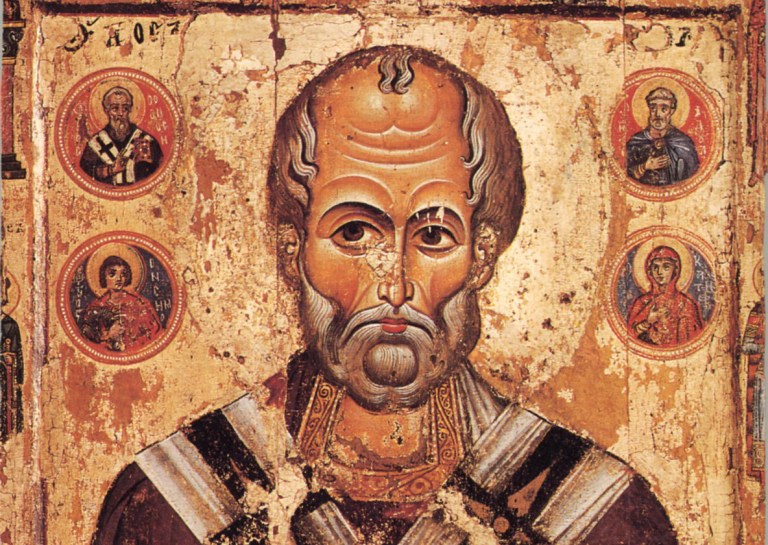In truth you were revealed to your flock as a rule of faith, / an image of humility and a teacher of abstinence; / your humility exalted you; / your poverty enriched you. / Hierarch Father Nicholas, / entreat Christ our God / that our souls may be saved. (Troparion to St. Nicholas)
22 May 2018, on the Feast of the Translation of the Relics of St. Nicholas from Myra in Lycia to Bari, His Eminence Metropolitan Vladimir celebrated the Divine Liturgy in the Nativity of the Lord Cathedral in Chisinau.
Praying with the church-goers was the President of the Republic of Moldova, Mr. Igor Dodon.
During the Divine Service, deacon Serghei Barbu was ordained priest and appointed to the parish of St. Basyl the Great in the sector of Botanica, Chisinau.
Metropolitan Vladimir wished the newly-ordained cleric to be worthy of his high mission and vocation, and always to ask in his prayers for the heavenly intercession of St. Nicholas.
It should be mentioned, that Metropolitan Vladimir has a very special spiritual relation with St. Nicholas, for the saint’s name was given to him at baptismal. In addition, today, on the Feast of the Translation of the Relics of St. Nicholas, Metropolitan Vladimir celebrates the forty-fourth anniversary since priesthood ordination and mission at the Lord’s Altar.
On this pleasing event, archpriest Vadim Cheibas, the Metropolitan Secretary and Cathedral Dean, congratulated His Eminence Vladimir on behalf of the entire synaxis of priests and deacons, wishing long live and the Lord’s heavenly protection at the helm of the Orthodox Church of Moldova.
Synodal Sector of Institutional Communication and Mass-Media Relations
x x x
Sainted Nicholas the Wonderworker, Archbishop of Myra in Lycia – the Transfer of the Relics from Lycian Myra to Bari in Italy
Commemorated on May 9
Sainted Nicholas the Wonderworker, Archbishop of Myra in Lycia – the Transfer of the Relics from Lycian Myra to Bari in Italy: The Vita about his life is located under the 6 December feastday.
In the XI Century the Byzantine Greek empire was living through some terrible times. The Turks put an end to its influence in Asia Minor, they destroyed cities and villages, the murdered the inhabitants, and they accompanied their cruel outrage with the desecration of churches, holy relics, icons and books. The Mussulmen attempted also to destroy the relics of Saint Nicholas, deeply venerated by all the Christian world.
In the year 792 the caliph Aaron Al’-Rashid sent Khumeid at the head of a fleet to pillage the island of Rhodes. Having lain waste this island, Khumeid set off to Lycian Myra with the intent to rob from the tomb of Saint Nicholas. But instead of it he robbed another, standing alongside the crypt of the saint. Just as they succeeded in committing this sacrilege, a terrible storm lifted upon the sea and almost all the ships were shattered into pieces.
The desecration of holy things shocked not only Eastern, but also Western Christians. Christians in Italy were particularly apprehensive for the relics of Saint Nicholas, and among them were many Greeks. The inhabitants of the city of Bari, located on the shores of the Adriatic Sea, decided to save the relics of Saint Nicholas.
In the year 1087 merchants from Bari and Venice set out to Antioch for trade. Both these and others also had proposed on the return trip to take up the relics of Saint Nicholas and transport them to Italy. In this plan the men of Bari commissioned the Venetians to land them at Myra. At first two men were sent in, who in returning reported that in the city – all was quiet, and in the church where rested the glorified relics, they encountered only four monks. Immediately 47 men, having armed themselves, set out for the church of Saint Nicholas. The monk-guards, suspecting nothing, showed them the raised platform, beneathe which was concealed the tomb of the saint, where by custom, they anointed foreigners with myrh from the relics of the saint. The monks told them during this about an appearance of Saint Nicholas that evening to a certain elder. In this vision Saint Nicholas ordered the cautious preserving of his relics. This account encouraged the barons, – they saw an avowal for them in this vision and as it were a decree from the saint. In order to facilitate their activity, they revealed their intent to the monks and offered them money – 300 gold coins. The monk-guards refused the money and wanted to warn the inhabitants about the misfortune threatening them. But the newcomers bound them and put their own guards at the doorway. They took apart the church platform beneathe which stood the tomb with the relics. In this effort the youth Matthew was excessive in his especial zeal, wanting to as quickly as possible to find the relics of Saint Nicholas. In his impatience he broke the cover and the barons saw, that the sarcophagus was filled with fragrant holy myrh. The compatriots of the barons, the presbyters Luppus and Drogus, made a litany, after which the break of Matthew began to flow with myrh from the overflowing sarcophagus of the relics of the saint. This occurred on 20 April 1087.
Seeing the absence of a container chest, presbyter Drogus wrapped the relics in the cover cloth, and in the company of the barons he carried them to the ship. The monks – having been set free, alerted the city with the sad news about the abduction of the relics of the Wonderworker Nicholas by foreigners. A crowd of people gathered at the shore, but it was too late…
On 8 May the ships arrived in Bari, and soon the joyous news made the rounds of all the city. On the following day, 9 May 1087, they solemnly transported the relics of Saint Nicholas into the church of Saint Stephen, situated not far from the sea. The solemn bearing of the relics was accompanied by numerous healings of the sick, which inspired still greater reverence for the Saint of God. A year afterwards a church was built in the name of Saint Nicholas and consecrated by Pope Urban II.
This event, connected with the transfer of the relics of Saint Nicholas, evoked a particular veneration for the Wonderworker Nicholas and was marked by the establishing of a special feastday on 9 May. At first the Feastday of the Transfer of the Relics of Saint Nicholas was observed only by the people of the city of Bari. In the other lands of the Christian East and West it was not adopted, despite the fact that the transfer of the relics was widely known about. This circumstance is to be explained by the custom in the Middle Ages of venerating primarily the relics of local saints. Moreover, the Greek Church did not establish the celebration of this remembrance, since for it the loss of the relics of Saint Nicholas was a sad event.
The Russian Orthodox Church celebration of the memory of the Transfer of the Relics of Saint Nicholas from Lycian Myra to Bari in Italy on 9 May was established soon after the year 1087, on the basis of an already established veneration by the Russian people of the great Saint of God, brought over from Greece simultaneously with the acceptance of Christianity. The glorious accounts about the miracle-workings, done by the saint on both land and sea, were widely known to the Russian people. Their inexhaustible strength and abundance testify to the especially graced help of the great Saint of God for suffering mankind. The image of Saint Nicholas, a mighty Wonderworker and Benefactor, became especially dear to the heart of the Russian people, since it inspired deep faith and hope for his intercession. The faith of the Russian people in the abundant aid of the Saint of God was marked by numerous miracles.
A significant body of literature was compiled about him very early in Russian writings. Accounts about the miracles of Saint Nicholas done in the Russian land were recorded early on in deep antiquity. Soon after the Transfer of the Relics of Saint Nicholas from Lycian Myra to Bari, there appeared a Russian redaction of his Vita and an account about the Transfer of his holy relics, written by one contemporary to this event. Earlier still was written a laudation to the Wonderworker. And each week on Thursday, the Russian Orthodox Church honours his memory in particular.
In honour of Sainted Nicholas were erected numerous churches and monasteries, and with his name Russian people are wont to name their children at Baptism. In Russia are preserved numerous wonderworking icons of the saint. Most reknown among them are the images of Mozhaisk, Zaraisk, Volokolamsk, Ugreshsk and Ratny. There was neither house nor temple in the Russian land, in which there was not an image of Saint Nicholas the Wonderworker. The significance of the graced intercession of the great Saint of God is expressed by the ancient compiler of the Life-Vita, in the words of whom Sainted Nicholas “did work many glorious miracles both on land and on sea, aiding those downtrodden in misfortune and rescuing the drowning, carried to dry land from the depths of the sea, raising up others from corruption and bringing them home, liberating from chains and imprisonment, averting felling by the sword and freeing from death, and granting much healing to many: sight to the blind, walking to the lame, hearing to the deaf, and speech to the mute. He brought riches to many suffering in abject poverty and want, he provided the hungry food and for each in their need he appeared a ready helper, an avid defender and speedy intercessor and protector, and such as appeal to him he doth help and deliver from adversity. Both the East and the West know of this great Wonderworker, and all the ends of the earth know his miracle-working”.
© 1996-2001 by translator Fr. S. Janos.
Source: holytrinityorthodox.com






